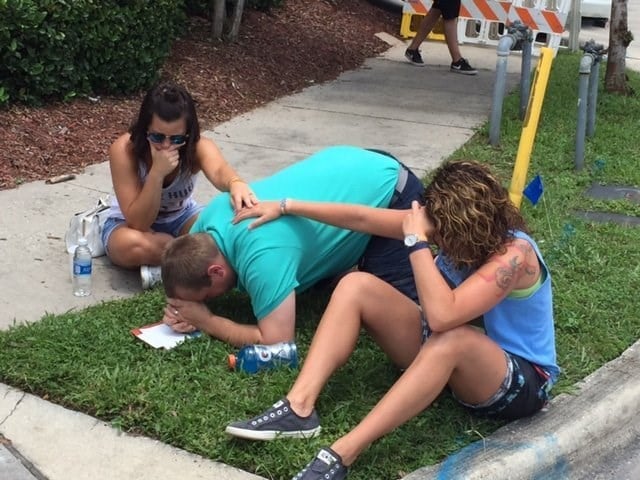Photo by: Ed Clark
Image source: http://www.thegreatleapsideways.com/?p=209
When I first looked at this image, I wasn’t paying attention to the man, but my eyes first caught the woman standing in the background with the white hair cover. Her facial expression, of what seems to portray a feeling of uncertainty as to what she was seeing then made me look at the military man. The man, obviously crying, seems to be the most emotional person in the setting. I get the feeling of a funeral, but of what seems to be a small ceremony. He seems to be looking up to the sky, what I believe to be heaven, and allowing his emotions to take over. He seems to be very overcome by his emotions, and makes me question why no one else is, but instead they are staring at him. Is this the truth of the image? Is what I feel the image is showing what the photographer wanted us to see? Just as Donald Weber states, “Today, the photographer, the storyteller, has the control of stories if he or she accepts that responsibility. You can tell a story, and, most importantly, you can show it to the world. We are not limited to a set of outlets. The outlet is you”.
Photographic, Artistic and Compositional Principles
Rule of Thirds: The main subject seems to be to the left of the image, being placed to the left outer third. The photographer allowed for us to also see to the right of the image, or right outer third other people at the same event of the main subject. I believe the photographer did this to purposely allow us to absorb the feeling of emotions the main subject is feeling, but to also show us a difference between his emotions and the others.
Obvious Main Subject: The photographer allowed for the main subject to be obvious as his presence is larger and more zoomed in. It also was allowed for a smaller fraction, about a third of the image to be outsiders to the subject. If the third of the image with the others was not in the photo I feel it would have made it difficult to understand the intensity of the subjects emotions. It also would have made it difficult for me to figure out what the setting was.
Background Compliments and Distracts from Composition: The background of people are a little more out of focus then the main subject, and seems to have been a distraction and also a compliment to the subject. The background gave for more detail to what was occurring and the setting, and also allowed for you to reflect on the emotions and compare. But, it was also a distraction as the first thing my eyes were drawn to wasn't to the main subject but the woman in the background.
Image of Truth
Image by: AFP/Getty Images
This photo represents the meaning of truth to me. This is an image taken of people praying in Orlando after the Night Club shooting this past weekend killing 50 and injuring 50 people. It shows you the truth of our world and how hate has started to consume many. It gives you an understanding of the reality in what is happening around us. When I first saw this image it made me cry. It was so powerful that I could feel the pain and emotion the subjects were feeling. As Patrick Kiger states in his article, "Words may strive to appeal to the logical portion of our minds. But the images captured by photojournalists – from Robert Capa‘s photos of heroic GIs struggling to reach shore on D-Day to UPI photographer Johnny Jenkins‘s outrage-provoking photo of African American high school student Elizabeth Eckford being harassed by a mob in Little Rock in 1957 – often take hold of our hearts and reach us on a more primal emotional level". I don't believe words could describe this photo and allow you to feel the emotions, you just have to see it to feel it and to believe it. This tragic event and almost all the tragedies to be happening today that are captured by photojournalist are stirring up the bias in these situations. It seems that lately when something tragic happens it gives people this idea that they need to voice their bias opinions on these events, and try to force others to believe what they believe as to "Why" this person did this, and "why" this happened. As John Nordell states, "So I think in our image saturated time, its a vital importance to look at the biases of the publications that present imagery, its a vital importance to look at the possible biases of the photojournalists that created the images as well as taking a look at what our own biases may be".
Photographic, Artistic and Compositional Principles
Subjects Expression: The subject's expression seems appropriate for the situation. He is showing true emotion, sadness and hopelessness after a massive terrorist attack over the weekend in Orlando Florida at Pulse night club, where 50 were killed, and 50 injured. You can't see his face, but his body position shows his emotions.
Feelings Image Creates: This image brings alot of emotions, as it truly pulls at your heart. You can feel the pain these people are feeling. It gives you a sense of connectiveness with the image and subjects. It makes me want to jump in the photo and join them in prayer and grief and give them a comforting hug.
Keep it Simple: The composition is simple. The journalist capturing this photo made sure to focus on the subjects of the image, and kept it simple. The closeness to the subjects keeps it simple.
Image No Truth
Image by: LEE ABBAMONTE
This photo of Alex Rodriguez, New York Yankee player who was caught lying about using steroids. He is a professional ball player, who has fans that are very young, and look up to him as a role model. He is not an example of a what it means to be a role model or a positive influence. But, that may just be my own bias, right? With him being so famous, he brings up alot of bias in the position of whether he should play or not. His publicity does not help with removing our own bias as looking at him as a professional player who simply has a job and has broken the rules. People can't separate him as an employee from being a superstar. As Donald Weber states, "Just because a photo looks like photojournalism, doesn’t mean it’s Photojournalism". Is this a subject photojournalism worthy, or are what some may deem as more important news?
Photographic, Artistic and Compositional Principles
Obvious main subject: The photographer here has made it obvious of the main subject. He is the only subject in the photo. There are no distractions.
Image in color: The image is in color and I feel it is appropriate for our times. The photographer might had kept it in color for a reason. Perhaps to allow for the viewers to see the colors of the blue representing the New York Yankees team color.
In or Out of Focus: The main subject is in focus. The image seems very sharp. Almost looks like you are actually seeing him in person.



No comments:
Post a Comment